This month’s 2010/11 outlook is shaped by the first survey-based forecasts for US corn and sorghum production. The 2010 corn crop is forecast to be a new record. Sorghum production is forecast up slightly from last year. Corn food, seed, and industrial use and exports are both projected higher with the larger crop. Ending stocks for the four feed grains in 2010/11 are projected down from last month and down from 2009/10. Prices are expected to be stronger, with tighter domestic stocks and lower international grain supplies. Prospects for 2010/11 global coarse grain production decline this month mostly due to unfavorable weather across Europe, especially in Russia. The United States is expected to benefit from increased world corn trade and reduced competition, with 2010/11 corn exports projected up 100 million bushels this month to 2.05 billion.
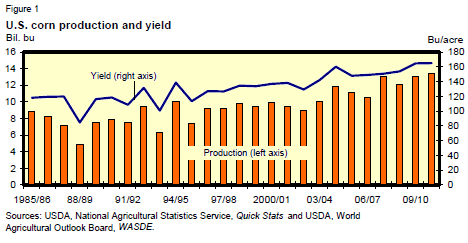
Feed Grain Supply Prospects Increase
US feed grain production in 2010 is forecast at 354.5 million metric tons, up 3.9 million from a month ago and up 5.5 million from 2009. Production from last year is up for corn and sorghum but down for barley and oats. Feed grain supply in 2010/11 is forecast at 397.2 million tons, up 2.6 million from last month but down 1.1 million from 2009/10. Forecast beginning stocks are lowered 1.3 million tons from last month and are down 6.4 million tons from the previous year.
Total feed grain use is projected at 360 million tons in 2010/11, up 3.9 million from last month and up 2.3 million from the previous year. The year-to-year increase reflects higher projected exports and smaller increases in domestic uses. Feed and residual use in 2010/11 is expected to total 141.9 million tons, up 0.3 million from last month but down 5 million from 2009/10. Food, seed, and industrial (FSI) use, at 161.9 million tons, is up 0.7 million from last month reflecting increases in corn sweeteners and starch use. FSI is projected up 5.7 million tons from 2009/10, mostly reflecting higher corn use for ethanol. Exports are forecast at 56.1 million tons, up 2.7 million from last month and up 1.5 million from last year.
The US Bureau of the Census issued revised numbers for 2009, which primarily moved some trade from one month to the next. Imports are unchanged for 2008/09, even with small monthly changes, but 2009/10 is up 100,000 metric tons. Market year exports for feed grains in 2008/09 are lowered from 51.2 million tons to 50.9 million. In 2009/10, exports are raised from 54.0 million tons to 54.6 million, mainly from an increase in corn exports. Ending stocks for 2009/10 are lowered 41.9 million tons to 40.6 million.
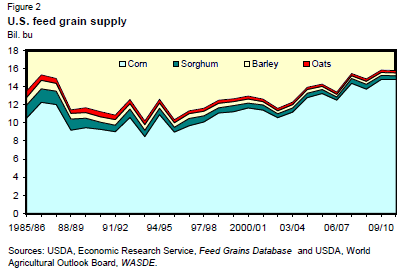
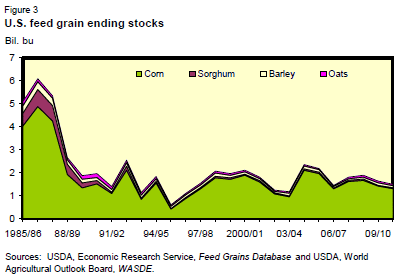
When converted to a September–August marketing year, feed and residual use for the four feed grains plus wheat in 2010/11 is projected to total 148.0 million tons, up 0.4 million from last month but down 1 per cent from the 2009/10 forecast of 149.7 million. Corn is estimated to account for 92 per cent of total feed and residual use in 2010/11, down from 94 per cent in 2009/10.
The projected index of grain-consuming animal units (GCAU) for 2010/11 is expected to slightly increase from the 2009/10 forecast of 91.6 million units. The grain used per GCAU is projected at 1.61 tons, down from 1.64 tons in 2009/10. In the index components, GCAUs for all types of poultry, hogs, and dairy cows are up, while those in other categories are down slightly, with cattle on feed being down the most. Increase in GCAU units is due to moderate export demand for beef, pork, and broilers, partly reflecting recent strong shipments to Japan and South Korea. Stronger demand from a number of markets is expected to support higher growth of exports in the broiler sector, reflecting increased chicks placed, table eggs production, and broiler export demand this month. Weekly broiler egg sets and chicks placed have been increasing as grain prices moderated.
As a result, broiler meat production is expected to be up 3 per cent in both 2010 and 2011 from the year earlier. In 2010, egg production is expected to be up 1 per cent from 2009 and in 2011, up another 1 per cent. In 2010 turkey meat production is expected to be down 2 per cent from 2009. Turkey production is expected to rebound modestly in 2011, rising 2 per cent from 2010. Pork production in 2010 is expected to be down 3 per cent from 2009 but rebound in 2011, increasing 2 per cent on the year. Forecast milk production is raised as producers continued to add cows to the herd in the past few months and the rate of growth in milk per cow has increased.
Even though cattle on feed in feedlots with capacity of 1,000 or more head totaled 10.07 million head on July 1, 2010, up 3 per cent from last year, beef production in 2010 is expected to be down 1 per cent from 2009. Beef production in 2011 is expected to be down 2 per cent from 2010 as the July Cattle report had cattle outside feedlots down 1 per cent and the calf crop down 1 per cent.
Record Corn Crop Forecast
US corn production is forecast at 13.37 billion bushels, up 255 million bushels from last year and, if realised, the largest corn crop on record. Harvested acreage is forecast at 81 million acres for grain, unchanged from last month but up 1.4 million from last year. Based on 1 August conditions, yields are expected to average 165 bushels per acre, up 1.5 bushels from last month’s yield projection of 163.5 bushels and the actual 2009 yield of 164.7 bushels. If realised, this would be the highest yield on record.
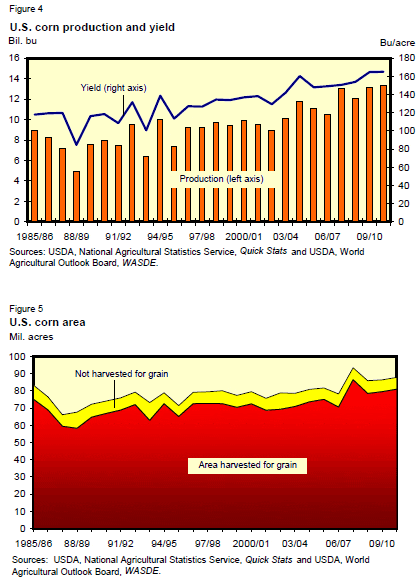
The 1 August corn objective yield data indicate the second highest number of ears per acre on record for the combined 10 objective yield States (Illinois, Indiana, Iowa, Kansas, Minnesota, Missouri, Nebraska, Ohio, South Dakota, and Wisconsin), only behind the record year of 2009. Record-high ear counts are forecast in Illinois, Minnesota, Missouri, and Wisconsin. As of 8 August, 71 per cent of the crop was rated in good to excellent condition in the 18 major cornproducing States, up 3 per centage points from a year ago.
Total corn use for 2010/11 is forecast up 130 million bushels to 13.490 billion bushels this month as a result of increased exports and FSI. FSI use is increased 30 million bushels to 6.090 billion. High-fructose corn syrup (HFCS) is raised 20 million bushels to 525 million as a result of expected increased exports to Mexico. Glucose and dextrose and starch are both raised 5 million bushels to 260 million and 250 million, respectively, for 2010/11. Corn used for ethanol remains unchanged this month at 4.7 billion bushels. As foreign feed wheat prospects are reduced this month, US exports for 2010/11 are increased 100 million bushels to 2.05 billion. Increases in production are more than offset by higher expected total use and lower carryin reducing projected ending stocks 61 million bushels this month to 1.312 billion.
For the 2009/10 marketing year, imports are lowered 2 million bushels to 8 million this month and exports are raised 25 million bushels to 1.975 billion, reflecting shipments to-date. Corn used in HFCS and glucose and dextrose are both raised this month to 515 million and 255 million bushels, respectively. HFCS was raised because of strong exports in June and a reduction in Mexico’s 2009/10 sugar production. Starch use is also increased 5 million bushels to 245 million. Ending stocks for 2009/10 are lowered 52 million bushels to 1.426 billion bushels.
US Bureau of the Census trade revisions included trade changes for calendar year 2009. In the 2008/09 marketing year, exports are lowered 9 million bushels to 1.849 billion bushels. FSI use is raised by 32 million bushels to 5.025 billion because of revision to monthly ethanol production by the Energy Information Administration. Together, the revisions lower feed and residual use 23 million bushels to 5.182 billion for 2008/09.
Corn prices received by farmers for 2010/11 are projected at $3.50-$4.10 per bushel, up 5 cents on both ends of the range this month. The marketing year average reflects higher prices for corn with tighter ending stocks and lower global feed grain supplies. The 2009/10 corn price remains unchanged at $3.50-$3.60 per bushel.
Sorghum Production Increases
Sorghum production is forecast at 383 million bushels, up 33 million from last month but nearly unchanged from last year. Expected area for harvest as grain is forecast at 5.2 million acres, unchanged from last month and down slightly from 2009. Based on 1 August conditions, yield is forecast at a record 74.1 bushels per acre, up 6.5 bushels from last month’s projection and 4.7 bushel from last year.
In Kansas, the top producing State, yields are expected to decrease by 6.0 bushel, from last year, while in Texas, the second leading State in sorghum production, yields are expected at 70.0 bushels per acre, up sharply from 48 bushels per acre last year. As of 8 August, 66 per cent of the sorghum crop was rated good to excellent, compared to 49 per cent a year earlier.
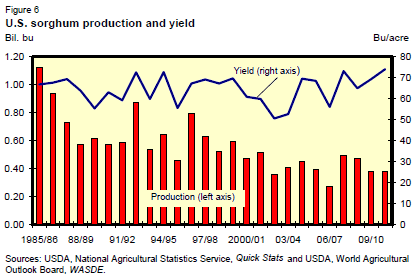
Total use for sorghum in 2010/11 is forecast at 370 million bushels, up 25 million from last month. Feed and residual use is up 15 million bushels to 120 million, reflecting increases in supply. Exports are raised 10 million bushels to 150 million, as increased imports to Mexico are expected. Ending stocks are raised 8 million bushels to 41 million.
The US Bureau of the Census has released trade revisions for calendar year 2009. This resulted in a small reduction in 2008/09 exports and a small increase to sorghum imports for the 2009/10 marketing year.
Sorghum prices received by farmers for 2010/11 are expected to average $3.20- $3.80 per bushel, up 5 cents on both ends of the range from last month, as reductions in global feed grain supplies raises prices for all feed grains. The 2009/10 sorghum price remains unchanged at $3.10-$3.20 per bushel.
Barley Production Prospects Up
Barley production for 2010 is forecast at 184 million bushels, up 2 million from last month but down 43 million from 2009. Based on 1 August conditions, producers expect yields to average 72.3 bushels per acre, up 0.7 bushels from last month. While the forecasted yield per acre is down less than 1 per cent from a year ago, the expected decline in production is more a reflection of the lowest planted acreage on record and the lowest expected harvested acreage since 1883. Area harvested for grain is forecast at 2.5 million acres, unchanged from last month but down 18 per cent from 2009. On 8 August, 83 per cent of this year’s crop was rated in good to excellent condition, compared with 78 per cent a year ago.
Total barley supplies in 2010/11 are raised 2 million bushels this month to 314 million, as a result of increased production. Total domestic use is forecast at 215 million bushels, unchanged this month. Exports also are unchanged this month. With higher production and no changes to use, ending stocks are projected up 2 million bushels to 89 million, which is down from 115 million in 2009/10.
US Bureau of the Census revisions for calendar year 2009 made minor changes to the 2008/09 barley exports. In the 2009/10 marketing year, imports were lowered slightly with a corresponding decrease in feed and residual use. Exports in 2009/10 were also raised slightly.
Prices received by farmers for barley in 2010/11 are expected to average $3.55- $4.15 per bushel, raised 5 cents on both ends of the range. This compares with $4.66 per bushel for 2009/10.
World 2010/11 Coarse Grain Production Projected Lower This Month
Prospects for global coarse grain production in 20101/11 declined this month as the drop in foreign production more than offset the US increase. World coarse grain area is still expected to expand, but average yield is likely to fall short of the 2009/10 record. World coarse grain production in 2010/11 is projected a bit above 2009/10 but slightly below 2008/09.
Foreign coarse grain production is down 13.6 million tons to 753.2 million. Weather systems stalled, with high pressure over the former Soviet Union, causing severe drought in the spring and summer across Kazakhstan and much of Russia, excessive rains over the eastern countries of the EU, and some dryness across the UK and northern parts of France and Germany. Foreign barley production is cut 7.6 million tons to 123.9 million, foreign corn is reduced 3.8 million tons to 492.1 million, rye is cut 1.3 million tons to 13.6 million, and oats are trimmed 0.7 million tons to 22.6 million.
Russia’s barley production is reduced 3.0 million tons to 10.0 million as harvest reports confirm that drought has devastated spring barley yields across the Volga and Central regions. Barley production in Siberia is less damaged by drought than other parts of Russia, but is not expected to match the previous year’s high yields. Russia’s 2010/11 barley harvest is projected to fall to less than half the average of the previous two years. The drought moved into the Southern District of Russia later than in the Volga, but exceptionally hot temperatures in early August damaged filling corn, cutting corn prospects 1.5 million tons to 3.5 million. Russia’s rye is cut 0.8 million tons to 2.5 million and oats is reduced 0.5 million tons to 4.5 million. Millet production is also reduced 20 per cent this month.
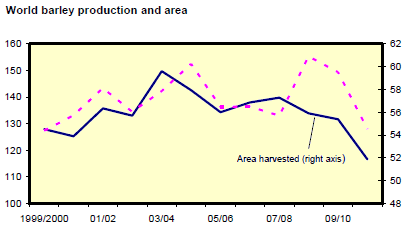
In Ukraine, excessive rains in the western areas during the filling and harvest of barley promoted disease, reduced quality, and cut barley production 1.5 million tons to 9.0 million. In the north-central and eastern parts of Ukraine, drought spilled over from Russia, limiting soil moisture and searing corn with extreme temperatures during grain fill. Reduced input use is reported, especially of fertilizer, also limiting yields. Corn production is cut 1.5 million tons this month to 11.5 million. Oats and rye production prospects are also reduced this month. Kazakhstan’s barley production is reduced 0.5 million tons to 1.3 million due to drought, while production in Belarus is trimmed 0.1 million tons to 1.9 million because of excessive rains during harvest. Armenia reported a small increase in barley production based on larger area and yields.
EU barley production is reduced 1.5 million tons this month to 54.8 million as harvest reports for several countries indicated lower yields. The largest declines were for Spain, France, and Germany. EU corn production prospects are reduced 1.0 million tons this month to 56.0 million, with reductions for France and Germany. EU reductions this month for rye (0.4 million), oats (0.1 million), and mixed grains (0.1 million) are mostly due to reduced yield prospects in Germany. Outside the EU, Croatia’s coarse grain production prospects increased slightly as reduced barley area and production was more than offset by increases for corn.
Algeria’s barley production is reduced 0.6 million tons to 1.4 million as yields were reported to be significantly less than the previous year’s record level. India’s barley production is reduced 0.3 million tons to 1.3 million due to lower reported yields. In Mexico, ample rains boosted 2010/11 sorghum production prospects 0.1 million tons to 7.1 million, but the previous year’s crop is revised lower.
World coarse grain beginning stocks for 2010/11 are down because of a reduction in US corn. Foreign beginning stocks are up 0.4 million tons to 147.2 million as several changes, mostly to 2009/10 trade, are nearly offsetting. South Africa’s corn beginning stocks are increased 1.0 million tons due to reduced estimated domestic use in 2009/10 while Argentina’s beginning stocks are reduced 1.0 million tons because of increased exports. Reductions for coarse grains beginning stocks for Indonesia Australia, Mexico, and Ukraine were not enough to offset increases for Brazil, Turkey, Iran, Viet Nam, India, Canada, and Venezuela.
Global Coarse Grain Use Projected Lower
World coarse grain use for 2010/11 is forecast down 2.4 million tons this month to 1,123.7 million. Reduced prospects for foreign countries more than offset the US increase. Several countries, including the EU (up 1.9 million tons), South Korea (up 0.5 million), and Israel (up 0.4 million), are expected to increase corn feed use due to tight supplies and increased prices for low-quality wheat. China’s corn consumption is increased 1.0 million tons this month as continuing imports demonstrate strong demand. There are also small increases this month in India, Libya, Turkey, and Armenia.
Drought and a ban on grain exports by Russia have raised wheat prices compared to coarse grain prices in most of the world. Russia is expected to increase wheat feed use, as the export ban increases wheat available to the domestic market, offsetting reduced feed grain production. Russia’s feed grain use is reduced 4.5 million tons this month, with feed and residual cut 3.7 million tons. Coarse grain use is forecast lower this month due to production problems in Ukraine, down 0.5 million tons; Kazakhstan, down 0.4 million; and Belarus, down 0.2 million. Reduced corn supplies are expected to constrain use in Indonesia, down 0.4 million tons. South Africa’s corn use is revised 0.6 million tons lower in line with the previous year’s reduction. There are also small downward revisions this month for coarse grain use in Syria, Jordan, Australia, and Croatia.
World coarse grain feed and residual use for 2010/11 is down 1.3 million tons this month, but global disappearance is down 2.4 million tons. Part of this is due to reductions in food, seed, and industrial use, especially in Russia. However, much of the reduction in disappearance is due to changes in local marketing year trade. World coarse grain imports for 2010/11 are raised 2.2 million tons this month, with a 1.2-million-ton corresponding increase in exports. This reduces global 2010/11 disappearance. It is also consistent with increased Southern Hemisphere exports from local marketing year 2009/10 that occur during the October-September trade year 2010/11.
World Coarse Grain Stocks Projected Lower
Global coarse grain ending stocks for 2010/11 are projected down 8.1 million tons this month to 172.0 million. Much of the decline is for barley, with world corn stocks trimmed only 1.9 million tons to 139.2 million. Though down month-tomonth, world ending stocks of corn are nearly the same as beginning stocks, an indication that production and demand for corn are expected to be exceptionally well balanced in 2010/11.
World barley trade projected for 2010/11 is reduced 0.6 million tons to 15.9 million due to reduced global production, Russia’s export ban, and increased prices. Ukraine’s exports are cut 1.2 million tons to 4.0 million; Russia’s exports are reduced 0.6 million tons to 0.4 million; with smaller reductions for Kazakhstan and India. The EU, with large stocks, is expected to have strong exports, up 1.0 million tons this month to 4.6 million. Australia’s barley exports are increased 0.4 million tons this month to 4.0 million.
US sorghum exports for 2010/11 are increased 0.2 million tons this month to 3.8 million. Increased US production prospects and strong demand from Mexico are expected to boost trade.
Further Reading
| - | You can view the full report by clicking here. |
August 2010


